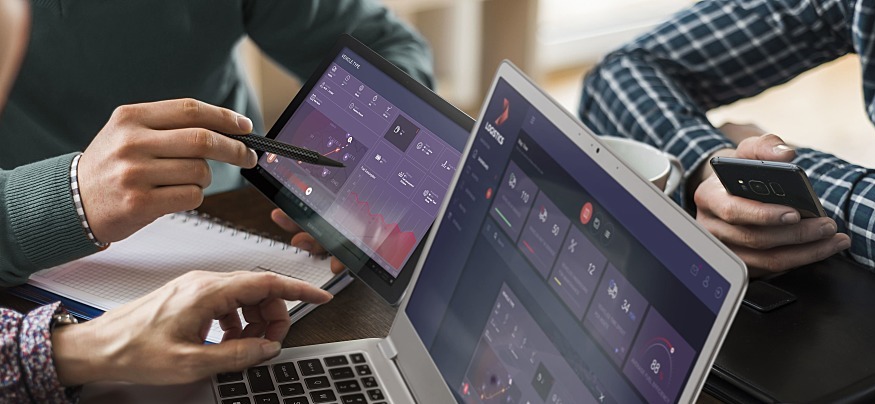2018 is set to be a critical year for government technology transformation and digitization efforts. New mobile devices, virtual reality (VR), Internet of Things (IoT) and other enterprise technological advances that emerged in 2017 will infiltrate agencies to fundamentally change how government does business.
Thanks to movement on the Managing Government Technology (MGT) Act, which was signed into law in the final weeks of 2017 as part of the National Defense Authorization Act for FY2018, a new fire has been lit to drive these efforts forward in an unprecedented way. IT budget funds are being steered away from costly, insecure legacy systems to modernization projects that will enable better citizen service delivery, empower military advantage on the battlefield and drive new levels of workforce productivity.
With these exciting forces at play, here are four predictions we anticipate will impact agency operations in the year to come:
1. IoT will force an endpoint security revolution. Federal cybersecurity efforts were further highlighted in 2017 with the Cybersecurity Executive Order. While there are well-established issues to tackle, federal agencies will be forced to turn an eye to an expanding ecosystem of mobile endpoints introduced by new government and military IoT technologies and applications. The growing number of internet-connected devices — from autonomous vehicles to wearables, drones and more — will put agencies and contractors under the gun to ensure those endpoints are secured.
Policymakers will play a critical role in defining next steps for identifying what an endpoint is and guidelines for adoption. For example, the Internet of Things (IoT) Cybersecurity Improvement Act of 2017, a bipartisan bill introduced in August, would require that devices purchased by the U.S. government meet specific security requirements.
Digitize Your Government Agency
Get this guide to drive collaboration, boost productivity and ensure security in the public sector. Download Now
Another potential source of continuing IoT security guidance is the National Institute of Standards and Technology (NIST), which is trying to address endpoint practices more fully in light of mobile and IoT expansion. Regardless of policy-driven directives, however, the IoT is largely uncharted territory, and many federal IT leaders will face unique situations that require agency-driven controlled deployment solutions.
2. Increasing mobility adoption will help close the millennial talent gap. According to a GovLoop analysis of Office of Personnel Management data, millennials comprise an average of 17.75 percent of agency employees. Among new employees, only the Justice Department leads the government with 70.2 percent drawn from the youngest generation of workers. While studies show a variety of reasons why younger workers would turn down or quit a job, outdated or ineffective technology is a common thread.
Millennials, the first generation to come of age in a world of ever-present mobile technology, have been using it for most of their lives and want a workplace that embraces the latest productivity tools. All of this means that in 2018 and beyond, federal agencies will need to increasingly equip employees with mobile devices if they hope to attract and retain talent.
3. Mobile devices will drive more mission-critical apps and value. It’s common for an employee to have a desktop at the office, a laptop for travel and a mobile phone and/or a tablet for in-field use. As mobile devices grow in computing power, we are on the cusp of a new era that will make multiple devices unnecessary for many federal employees. Connecting keyboards and monitors to their mobile devices — to ease tasks such as typing or analyzing detailed documents — can be all that’s needed to enable employees to carry out their work on the go.
According to a Frost & Sullivan study (commissioned by Samsung), employees say they gain 34 percent productivity through using a smartphone for work. As agencies become more confident in their endpoint security measures, they will grow more comfortable with a mobile-first and one-device approach for many of their employees.
Stronger security policies, training and technology such as malware protection, biometrics, encryption and containerization will help agencies move beyond where they are stuck today — which is defining their mobile strategies as supporting mostly basic applications such as email and calendars. This year, agencies will begin to take advantage of more mission-critical productivity apps for use cases such as in-field data collection, logistics management and more, allowing them to better tackle work where it happens.
4. Immersive technologies will become untethered and more intelligent. The U.S. Department of Defense is accelerating investment in live, virtual, constructive and mixed-reality training, with the Navy alone expecting to spend between $6 billion and $6.12 billion on training and simulation each year until 2021, according to Frost & Sullivan. VR technologies have advanced rapidly, and now provide a viable alternative to traditional live training that is safer, more cost-effective and versatile.
In 2018, immersive training technologies will for the first time become fully mobile and untethered experiences. Built on robust mobile devices, new decision analytics, machine learning and artificial intelligence (AI) capabilities will add an additional layer of realism to simulation content, enabling trainers to cut the cord for more portable, on-demand high-fidelity modules that will deliver training whenever and wherever it’s needed.
Of course, circumstances can change rapidly and nobody really knows what the future will bring. 2018 promises, however, to be a year of continued movement to decentralized and mobile work. The IoT is coming into its own and nearing critical mass. Changing workforce demographics are providing a bottom-up impetus for modernizing technology and driving digitization, while Congress and the White House are bringing pressure from the top to maximize technology budgets and current investments.
As agencies respond to these congruent demands, mobility, endpoint security and workforce development will rapidly evolve and advance this coming year.
Learn more about how mobile technologies can help the federal government better serve its mission and meet the evolving demands of tomorrow.








